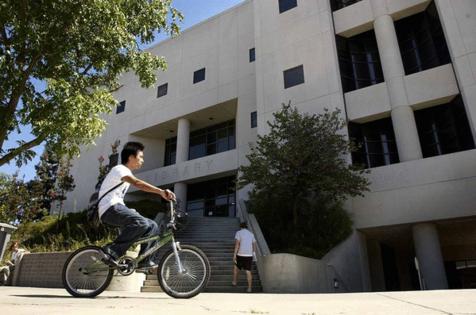Is California community college accessible? Report, students identify barriers in affordability
Published in News & Features
SACRAMENTO, Calif. — Community college has a reputation as the most accessible way to receive a college degree. It’s low cost compared to four-year universities and everyone is granted admission.
For community college students in California, there remains serious challenges in getting a degree.
Sofia Aloise, 23, who attends Sierra College in Rocklin, says its the additional costs that comes with college.
She works full-time at Jamba Juice and an on-campus job on top of juggling 16 units of coursework. She pays rent with the apartment she shares with her mother, car insurance, groceries, bills, books, anything that keeps her afloat on a daily basis.
“Community college is not a walk in the park like everyone makes it seem,” she said.
Aloise is one of the 1.9 million of students attending a California community college, and like many of her peers, Aloise has faced serious financial barriers while in her studies. According to a report from the The Institute for College Access and Success and the Student Senate for California Community Colleges, challenges with affordability persist due to limited grant availability and additional costs.
Because of financial burden community college students face, transfer rates have been impacted, a state audit found this week. Transfer rates are lower for students from rural and lower income areas, including those from Black and Hispanic backgrounds, the report stated. The audit found that the transfer process is still a challenge for students to navigate.
Limited housing and obstacles to receiving aid
Aloise’s struggles are one Ivan Hernandez, a computer science major at Diablo Valley College in Pleasant Hill, can relate to.
Hernandez is a first-generation college student and solely relies on financial aid and other grants. On top of the standard costs of attending his college classes, he estimates that he spends an additional $3,000 per semester on transportation and books.
“I knew right off the bat that if I wanted to pursue higher education, it had to be by myself,” Hernandez said.
He also serves as the president of the student senate for California Community Colleges, where he hears stories from his peers across the state struggling to pursue higher education. He’s spoken to students living in their cars and students who struggle to maintain a full-time course load on top of work.
Finding housing has also been an obstacle for community college students. In California, there are 14 campuses with student housing, which is 12% of the California community college population. Most times, community college students live with their parents or have to scramble to find housing by themselves, said Hernandez.
Aloise and Hernandez both receive financial aid and grants to help alleviate the cost of college. But some of their peers across the state did not such receive financial assistance.
California community college students have struggled with receiving grant aid, even after they’ve applied. Almost half of community college students in California did not apply to receive a Pell Grant in 2020. Regarding the students who did apply, not all of them got financial assistance. Forty-two percent of those students didn’t receive any Pell Grant funds.
This hit harder for low income students, the report found. Even when accounting for grant aid, students still have to pay significantly out-of-pocket for other costs.
“With critical non-tuition costs like food and housing continuing to rise, it is becoming increasingly clear that existing levels of grant aid are not enough to alleviate students’ college affordability challenges.” the report reads.
Prioritizing work and transfer rates
The expense of college is impacting transfer rates for community college students. California is seeing persistent obstacles with community college students transferring within their four year goal. One in 5 students enrolled in community college from 2017 to 2019 did so during that four year period, according to a state audit released this week.
Community college students are still juggling with being able to afford a full-time course load, which makes the four year transfer goal more of a challenge. These students typically have to prioritize and accommodate their academic lives to their work schedules, like Aloise.
“Having to put work first before school, even though I don’t want to, it’s a necessity in order to keep myself from falling under,” Aloise said.
Because it takes longer to earn their degree, these students incur additional costs and have their financial aid eligibility exhausted prematurely, the report found.
Balancing paying the bills, affording college and maintaining a pathway to academic success is still a hurdle for California’s community college students. For example, 72% of students in fall 2021, who took entry-level classes required for their degree, were enrolled in less than 12 units, the standard number to be designated a full-time student.
The Institute for College Access and Success and the Student Senate for California Community Colleges called on financial aid reform to alleviate the burden of costs for community college students. Among its other recommendations, they proposed the California Student Success Completion Grant expand eligibility for students taking less than 12 units.
“One in five of all students who enrolled less than full-time in Fall 2021 took between nine to 11.9 units — just shy of the 12 units needed to be full-time,” the report stated. “Policymakers should explore whether those students should gain access to the SSCG to alleviate some of their financial burdens and replace work hours with full-time enrollment.”
____
©2024 The Sacramento Bee. Visit at sacbee.com. Distributed by Tribune Content Agency, LLC.







Comments